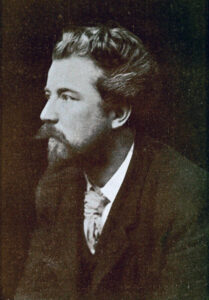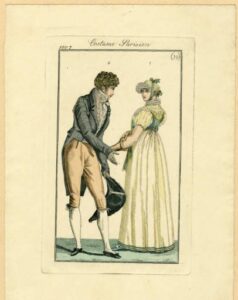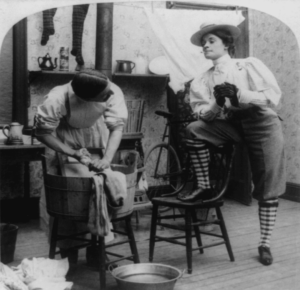The New Woman Movement in The Pagan Review’s The Pagans
© Copyright 2019 Omeir Syed Ali, Ryerson University
Introduction

The Pagan Review was a magazine written in the late 19th century by author William Sharp. It is a collection of short stories and poems under multiple pseudonyms by Sharp and consisted of stories focused on the deviancy of characters from the societal norms. The magazine was published in 1892 and is placed under the Yellow Nineties classification of literature written by Avante-Garde authors. This exhibit will examine the story “The Pagans” in The Pagan Review through its author, The New Woman Movement and Romanticism and focus on how it all ties into the theme of Nature, Craft and Consumption.
The exhibit will go through each piece of information in depth for the magazine. It will give a background of the author and his feminist ideologies, the other contents of The Pagan Review, the story “The Pagans”, The New Woman Movement and Romanticism and its connection to the main text. Thus allowing this exhibit to be a coherent and understandable piece about “The Pagans” and its interesting and important distinctions from other literary pieces of the late 19th century.
William Sharp (1855 – 1905)

William Sharp was born to a merchant father in the year 1855. His love of nature was strong from a young age, and he enjoyed the arts, poetry, writing and other forms of expressing a story (Denisoff, 2010). His upbringing led him to a career in writing, becoming an author going to university for English. His interest was incredibly focused on spiritism and folklore (Denisoff, 2010). Thus, his largest, and arguably best, work as akin to the idea of Paganism and the imaginative ideas of religion and the shift from social norms in society.
Editor and author of The Pagan Review, Sharp wrote under multiple pseudonyms, especially in the magazine The Pagan Review (Denisoff, 2010). In fact, the entirety of the magazine was written by Sharp, all short stories and poems, under these pseudonyms, and this was not found out until much after the publication of the magazine (Denisoff, 2010). His most interesting pseudonym was under a woman’s name “Fiona Macleod” (Halloran, 59).
Through Sharp’s writing, one can come to a consensus of his idea of what women’s roles in society and relationships were. Interestingly enough, it seems Sharps’s ideology could be considered very modernistic when taking into account that his writings were published during the late 19th century. Women, in his eyes, were on the same level as men, this kind of thinking was not the norm during the late 19th century. His focus on romances (Halloran, 59) allows us to understand how these ideals work into his fiction writing, showing the beginning of the New Woman movement being embedded into his works.
When looking at his other works there is even more evidence showing his feminist ideals. Sharp was well known for his poetry. Pharais (1894) was the beginning of Fiona MacLeod, a pseudonym Sharp used for many years, using his sister as the figurehead for her when she was needed in the public eye. (Halloran, 59). He also wrote the collections The Human Inheritance (1882), Earth’s Voices (1884), and Romantic Ballads and Poems of Phantasy (1888) (Denisoff). All these works had similar common themes when it came to folklore and spirituality (Halloran, 61). The idea of nature and the natural playing a part in the real and reality allowed for these poems to surpass the level of which others were held during the late 19th century. The fact that many of these works were also written under a woman’s name made it so Sharp could use a feminine point of view. Female authors and poets were a commodity during this age and while it could be seen as sharp trying to gear towards a certain audience, it can also attribute to his personal beliefs and how those beliefs were better expressed as a female writer than as a male one.
The Pagan Review
The Pagan Review includes seven entries, 5 short stories and 2 poems. Each piece of writing has the central theme of Paganism whether it be the idea of Religious Paganism, Social Paganism or any other Paganism. In essence, each story has an idea of not following the social norm. Be it in “The Black Madonna” with an immense religious difference to 19th century Catholicism or “Dionysis in India”, a story including Greek Mythology and the creatures of Greek myth being the main characters.
Not only are the stories themselves different in many ways, the form in which they come also veer from the social norm. For example, “Dionysis in India” is a story written in playwright. In a magazine filled with short stories and poems, it is very abnormal to have a play, one that never saw a stage in fact and an incredibly short one as well. Spanning around six pages only. It seems the art form of The Pagan Review was not just in the content of it, but the form of it as well. The way we read is very important to how we take in information and adding a sudden shift in a very set method throws readers off, which is what Sharp intended to do. In fact, he adds an epilogue at the end of the magazine so as to leave the reader wanting more.
The epilogue of The Pagan Review seemed to have been anticipated and an idea that Sharp wished to bring into fruition, however, it was never written nor published. The epilogue included promises of continuations of stories and poems in the first publication of the magazine, as well as new stories and poems written by different authors. It can be assumed that these were more pseudonyms, which is quite amusing as there is a portion in the epilogue which states “This Editor has been promised stories, episodes, studies… by several known and unknown authors,” (Sharp, 64). Sharp wished to use these names to continue his self written, self-edited work yet it was never published. Why? The answer is simple. The Pagan Review was not met with good critique (Coste, 4).
After The Pagan Review’s publication, many of the newspapers and critics for magazines, especially those of the avant-garde variety during this time period, took The Pagan Review as “Youth, which has usually nothing to say, is just anxiously to say it well. (Denisoff and Kooistra, 2010)” (Coste, 4). The magazine was deemed inexperienced work by multiple inexperienced authors due to the writing style, the content and the image it portrayed of youthful endeavours (Coste). This was not what the audience of these magazines was looking for, therefore another magazine for The Pagan Review could not be published.
The Pagans

“The Pagans” is a story focused on the main character, Wilfrid Traquair, who wishes to be with his love, Claire Auriol. The romance, like all other romances, has the main antagonist, Victor Auriol, who does not wish for this engagement between his sister and her lover to go through. The Auriols are a wealthy French family while Traquair is a small Scottish author, thus, to Victor, the match is improper.
This story is the cliche story of a woman torn between her love and her family. Rather than in other stories, this one does not have the woman become broken after her choice. Claire chose her love, and with that, she was no longer entitled to her family’s inheritance, which her brother controlled. But that did not deter her, she did not lose it, she did not get ‘emotional’, she was level-headed, confident in her choice and took the consequences without any intense response. In other words, she did what a regular person would do.
The late 19th century was the beginning of movements in accordance with equality for women in society. Thus, during this century, women were held at a lower standard than men. Stories such as this were interesting as they went against the norm of thinking when it came to relationships, which is what The Yellow Magazines was about, to be the anarchy to the norm through story writing. Because of this thinking, heterosexual romantic relationships had a set hierarchy, men above women. It is a depressing fact of the thinking in the West during the 19th century.
The New Woman Movement

The New Woman Movement began in the late 19th century and was prevalent in literature. “Sarah Grand is generally credited with coining the term in an 1894 article,”. The “New Woman” was the idea of women in society causing “radical change” socially, individually, publicly and professionally (Sellers). For hundreds of years, women have been seen as lesser than men in terms of biology, social standing and many other factors, this movement was the beginning of a fight towards these stereotypical views. Attacking these stereotypes about women allowed men to understand that they were not anchored in their stereotypes as well. It began an enormous social movement in which preached that a person’s gender did not specify the person they had to be, that there was more to them than just how they were biologically born.
The New Woman Movement played a large part in Western Feminism and Sharp seemed to have been a feminist before feminism was a term that existed. His stories showed women in lights far more modern and understanding than his counterparts during his life. The New Woman Movement was a literary heavy movement, Sharp being one of the authors who this movement could very easily be connected to. The simple fact that he had a pseudonym, his most famous, which was a woman’s name so that his poetry could be seen as though they came from a female perspective attributes to it (Halloran, 59). The movement was also indicative of “radical change” (Sellers) which is a theme in Sharps’ writing. “The Pagans” is a story of a radical shift in Claire’s life and her reaction to that change. One of calm collectedness which is not what women were shown as in literature and the media during this time. “…the New Woman calls women to action, encouraging them to become educated, free, and “self-supporting or wage-earning women,” (Sellers). In writing, women were shown as two specific stereotypes; submissive air-heads or seductive emotional vixens. A level-headed woman, like Claire, was an outlier to many other women in literature, which is what The New Woman Movement sought to show to the world.
Romanticism in the Late 19th Century
Romanticism is embedded in imagination, the thirst for a reality in which anything can be possible, it does not solely include romantic relationships or the love between two people (Sage). The idea of Romanticism was for everything to be seen in a romantic form, meaning through illogical and biased ways. To find the beauty in anything possible and allowing someone else to understand that beauty through one’s eyes.
“The Pagans” is full of romanticism.

It is in the diction that the author uses, the ideas that he portrays, the images that he brings to fruition. His word choice is flowery and elegant, entire paragraphs are written for a single purpose that could be explained in a simple sentence but romanticism can not be shown in simple sentences. It must be flamboyant and complicated to show an appreciation of even the simplest of things, like a nickname you have for a loved one. Romanticism is a subjective form of literature (Sage). It is included through a person’s eyes and the biases along with it, much like in “The Pagans”. Wilfrid, the narrator, continuously explores his relationship with Claire in a wonderfully endearing light. He loves her with so much of his heart that his words can be nothing but good for her. It is all he knows when he thinks of her. And while Claire may have faults and issues, we, the reader, do not know of any, because Wilfrid does not believe them wrong enough to counteract that love he feels for her. Thus, his bias is how we see Claire, and how we think of her as this perfect person. It is not because of objective truth, it is because of subjective love.
Conclusion
The fight for gender equality and the breaking of gender norms is long and still going. It is important to understand the highlights of that fight. The New Woman Movement was an extremely important aspect of feminism in the West during the late 19th century, especially in the literary community. William Sharp’s story “The Pagans” in his magazine The Pagan Review is an example of the Movement in literature through a male writer. Equality is not a fight that only women should be committing to, it is a fight that everyone should be a part of, regardless of gender, race, culture, or any other specific label. Sharp knew this nearly more than a hundred years ago, and it is a lesson well learned today.
Bibliography:
Coste, Bénédicte. Late-Victorian Paganism: The Case of the Pagan Review. Cahiers Victoriens Et Édouardiens, no. 80 Automne, 2014, pp. 2
Denisoff, Dennis. “William Sharp [pseud. Fiona Macleod, W.H. Brooks] (1855-1905),” Y90s Biographies, edited by Dennis Denisoff, 2010. Yellow Nineties 2.0, General Editor Lorraine Janzen Kooistra, Ryerson University Centre for Digital Humanities, 2019, https://1890s.ca/sharp_bio/.
Halloran, William F. “William Sharp as Bard and Craftsman.” Victorian Poetry, vol. 10, no. 1, 1972, pp. 57-78.
Sage, Vanessa. “Encountering the Wilderness, Encountering the Mist: Nature, Romanticism, and Contemporary Paganism.” Anthropology of Consciousness, vol. 20, no. 1, 2009, pp. 27-52.
Sellers, Kelli M. “Tossing the Pink Parasol: Rebecca of Sunnybrook Farm, the New Woman, and Progressive Era Reform.” Children’s Literature, vol. 40, 2012, p. 108-130. Project MUSE, doi:10.1353/chl.2012.0006.
